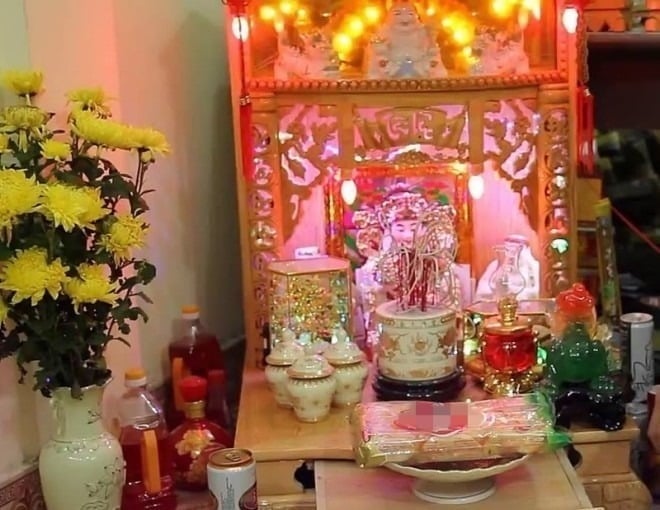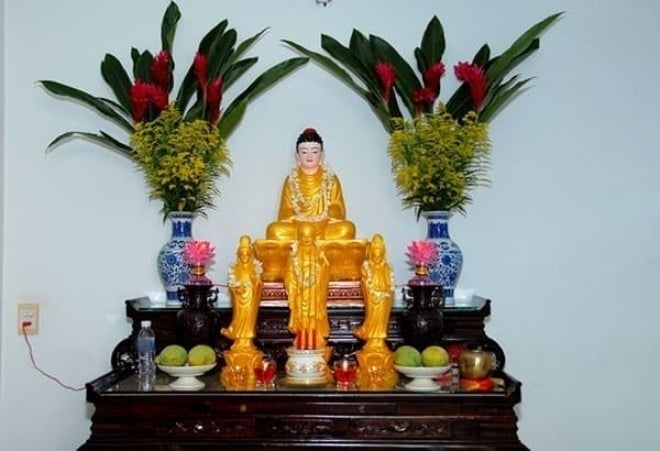On the first and full moon days of the month, as well as during holidays and death anniversaries, a flower vase is an indispensable part of the ancestral worship ritual. Arranging flowers on the altar not only shows reverence but also helps attract and accumulate fortune for the family.
Fresh flowers not only bring new life but also contain the essence of the sun and the sky, helping to create a fragrant and solemn worship space.
Placing a flower vase on the altar not only enhances positive energy but also attracts the blessings of ancestors and deities. However, not everyone knows the correct way to arrange flowers on the altar.
Why do wealthy families usually place a flower vase on the left side of the altar when burning incense?
Wealthy families tend to pay special attention to worship rituals and ceremonies, believing that arranging the altar according to Feng Shui principles shows respect to their ancestors and brings more fortune and blessings.
When there is only one flower vase, it is typically placed on the left side of the altar. This arrangement follows the rule of “east for flowers, west for fruits,” meaning the flower vase should be placed in the east direction while the fruit plate is placed in the west.

A single flower vase is typically placed on the left side of the altar.
According to natural laws, the sun rises in the east and sets in the west, and trees usually flower before bearing fruit. Therefore, placing the flower vase in the east and the fruit plate in the west aligns with these natural laws, ensuring smooth and favorable outcomes.
If the altar faces the main door in a southern direction, placing the flower vase on the left side (east) allows the fragrance of the flowers to permeate the room when the east or southeast wind blows, creating a serene and sacred worship atmosphere.
When using two flower vases, they should be placed symmetrically on both sides, with the fruit plate in the center, in front of the incense burner. This arrangement not only makes the altar look complete and cozy but also retains the original meaning of the flower vases.
In addition to the flower vases, the host should also pay attention to other worship items such as the three (or five) ceremonial utensils, the ceremonial tray, and the incense holder to add solemnity to the worship space. For smaller altars, such as those hung on walls, a single flower vase and an incense holder placed opposite each other may be sufficient.

Avoid placing too many flower vases on the altar as it can disrupt the balance and not bring additional positive energy to the worship space.
Avoid placing too many flower vases on the altar as it can disrupt the balance and not bring additional positive energy to the worship space.
The flower vase on the altar should be made of ceramic, porcelain, or glass, avoiding materials like copper or iron. The flowers used should have a gentle fragrance, no sharp thorns, and be neatly trimmed to ensure both spiritual value and safety.
Is it Advisable to Combine Two Banana Bunches for Ancestral Worship?
The debate surrounding the use of two banana bunches on an altar during rituals is intriguing. Some individuals opt for this practice when a single large bunch is unavailable, while others frown upon it. The question arises: why the discrepancy in opinions? Is there an underlying cultural or religious significance that dictates the use of a single bunch, and if so, what are the implications of deviating from this tradition?
The Ancient’s Warning: Why Building a House with the Door Directly Facing the Road Brings Misfortune
“The ancient art of Feng Shui has long guided people to avoid constructing homes with direct alignment between the front door and the back. But why is this so? Unraveling the mystery behind this age-old practice promises to reveal fascinating insights into the world of energy, harmony, and the delicate balance between human dwellings and the natural world.”






































